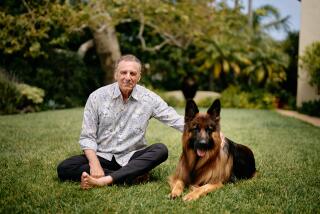The Naturalist and the Beloved : ALWAYS, RACHEL: The Letters of Rachel Carson and Dorothy Freeman, 1952-1964, <i> Edited by Martha Freeman</i> . <i> Introduction by Paul Brooks (Beacon Press: $35; 608 pp.)</i>
Rachel Carson was already an icon before she died in April 1964 at age 56. The best-selling author of three books on the natural history of the sea, hers was a trusted voice. Calm and imperturbable in the face of spurious attack by the chemical industry, she never wavered from her conclusions of corporate misuse, regulatory negligence and public betrayal. In “Silent Spring,” serialized in The New Yorker in the summer of 1962 and published that September, Carson dared to question not only the prolific use of chlorinated hydrocarbon pesticides but more fundamentally attacked the integrity of the scientific establishment and the assumptions of postwar industrial technology. When Carson died of cancer 18 months after the publication of “Silent Spring,” her ecological vision and her personal courage became the touchstone of the modern environmental movement. Her public image remained that of a very private but intellectually tenacious reformer.
Now, with the publication of “Always, Rachel,” a collection from some of the more than 750 letters between Carson and her much beloved, but seldom seen friend, Dorothy Freeman, the icon can be happily replaced. These letters reveal Carson as a warm, spirited, but lonely woman who, while producing some of the finest natural history of our time and starting an avalanche of concern for the future of life on this planet, depended upon almost daily evidence of devotion from the loving Freeman.
For the record:
12:00 a.m. June 18, 1995 FOR THE RECORD
Los Angeles Times Sunday June 18, 1995 Home Edition Book Review Page 8 Book Review Desk 1 inches; 15 words Type of Material: Correction
In “The Naturalist and the Beloved” (April 16, 1995), the reviewer’s name, Linda Lear, was misspelled.
Freeman, a busy housewife who spent most of her time in West Bridgewater, Mass., was Carson’s summer neighbor on the island of Southport off the coast of Maine. They met in 1953 after Freeman had written to welcome the famous author to the island community. Nine years older than Carson, Freeman shared with her a love of the natural world, especially the Maine seashore, a delight in birds and cats, good writing, music and the care of an aging parent. Carson found in Freeman’s nearly boundless capacity for love the understanding and devoted companionship of mind and spirit that her life had lacked. Their ensuing eleven-year relationship rooted her and provided the emotional framework she needed to create. Carson explained to Freeman, “All I am certain of is this; that it is quite necessary for me to know that there is someone who is deeply devoted to me as a person, and who also has the capacity and depth of understanding to share, vicariously, the sometimes crushing burden of creative effort.”
The correspondence between Carson and Freeman collected here has been carefully edited but not excerpted by Freeman’s granddaughter, Martha Freeman. Considerations of space and narrative eliminated some letters, but the principals also destroyed correspondence during their lifetimes. Although the omissions sometimes tease, there is enough to give us the first intimate picture of the private Carson. Valuable for what they tell of Carson’s work habits, and contributing new gems of her naturalist prose, the correspondence is primarily valuable for revealing the staggering family and health problems Carson carried while producing a book that literally changed the way we see the world. Important too is the assurance that Carson had a vigorous ego as well as an unwavering sense of her creative mission. While the two friends penned long, loving letters almost daily, and spent hours with each other on the telephone, Rachel’s commitment to her work always came first--a choice that makes Dorothy’s devotion all the more poignant.
When Carson finally finished “The Edge of the Sea” in 1955, which she dedicated to Dorothy and her husband, Stanley Freeman, Dorothy shared her joy, writing Carson: “Somehow I believe . . . that the fact that I can be in your life at this time will add to your pleasure in your success.” Yet in 1958 when Carson picked the seemingly ugly subject of pesticides as the focus for her next book Freeman objected. Eventually she accepted how vital it was for Carson to speak out. Deeply ill with a rapidly metastasizing breast cancer in 1962, Carson wrote Freeman, “I’m glad that before publication you have come to understand not only why it is important to me, but to the world. I knew . . . that if my time were to be limited, the thing I wanted above all else was to finish this book.”
Carson’s choice of Freeman as her emotional partner followed naturally from Carson’s circumscribed world. Even though she had more academic education than Freeman as a marine biologist, Carson spend her professional life as an editor for the Fish and Wildlife Service in Washington. Born in a tiny rural town not far from Pittsburgh, she never had the resources or the freedom to travel, and spent her adult life in Silver Spring, Md. Burdened with the care of her elderly mother, a diabetic niece and increasingly responsible for her niece’s young son, whom Carson formally adopted, the wonder is that Carson was able to produce the corpus of work she did. When “The Sea Around Us” provided financial independence, she built her Maine cottage, but was never freed of her familial obligations.
Although Carson and Freeman managed to see each other once in a while between summers, their correspondence reports more occasions of unsatisfied longing for the other’s presence. One of the most heart-rending came when Carson, alone in Maryland, heard from The New Yorker editor William Shawn that “Silent Spring” had achieved all that she had hoped. “I longed so for you last night to share my thoughts and feelings,” Carson wrote. Alone instead, she cuddled her cat in her arms and let tears of relief flow to the embrace of a favorite violin concerto.
Those readers who are familiar with the outlines of Carson’s life will rejoice in the discovery of the fullness of her relationship with Freeman. Others will discover a vibrant, caring woman behind the scientist who celebrated life while calling attention to how easily it could be destroyed. In a letter to Dorothy written for her to read after Carson died, the author celebrated “the joy and fun and gladness we have shared,” telling her: “Never forget, dear one, how deeply I have loved you all these years.” The triumph and tragedy is all here in a gracefully produced book, that was bravely undertaken, and that honors both women.
More to Read
Sign up for our Book Club newsletter
Get the latest news, events and more from the Los Angeles Times Book Club, and help us get L.A. reading and talking.
You may occasionally receive promotional content from the Los Angeles Times.





